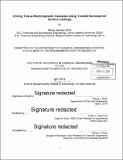| dc.description.abstract | Harnessing the synergy between materials at the nanoscale can be a valuable tool in understanding and probing cellular phenomena and in driving specific processes that lead to tissue and organ regeneration and repair. Biomedical implants attempt to materially replace damaged tissues, restore function, improve mobility, and alleviate pain. However, these implants often fail to recapitulate the original tissue properties. In the context of orthopedic implants, the functional success of an implant critically depends on its stable interaction and bonding with the host tissue. Yet, aseptic implant loosening accounts for over half of all joint replacement failures. Non-biological implant materials such as metals and plastics are used for their mechanical strength, but these are typically not suitable for direct integration with the host tissue. Conversely, traumatic wounds and congenital defects that result in large bone tissue defects are often corrected with autograft bone, which results in the matching of native bone tissue properties. However, the limited availability of donor bone coupled with pain at the site renders autografting suboptimal therapy. Permanent implants require multiple rounds of surgery and are often unable to recapitulate complex tissue reconstruction with high fidelity and carry the risk of inducing a foreign body response. Orthogonally, therapies to alleviate diseases in the bone such as osteosarcoma and osteoporosis are of significant interest to improve clinical outcomes. However systemic delivery of these therapies leads to toxic side-effects that limit their clinical use. These significant challenges to improving human health can be overcome by designing and combining materials with complementary biological properties. This body of work investigates the use of tunable, modular, nanoscale coatings that can prevent premature implant failure, induce targeted tissue repair by recapitulating aspects of the natural wound healing cascade and target therapy to the bone tissue. At the nanoscale, these coatings can impart multifunctionality to nanoparticles that can be used as a therapeutic agent. Central to the polymer-based multilayered coating, was a water-based layer-by-layer (LbL) deposition process, by which each component was introduced on the surface in nanoscale layers. On surrogate bone implants, coatings containing osteoconductive hydroxyapatite (HAP) and 5-10 pg of osteoinductive bone morphogenetic protein 2 (BMP-2) contained within the nanostructured coating acted synergistically to induce osteoblastic differentiation of endogenous progenitor cells in a rat. The tuned release of BMP-2 over 3-4 weeks, controlled by a hydrolytically degradable poly([beta]-amino ester), was essential for tissue regeneration and, in the presence of HAP, the modular coating encouraged the direct deposition of highly cohesive trabecular bone on the implant surface with an interfacial tensile strength that was 2-3 fold higher than implants coated with bioactive bone cement. Importantly, the failure was as a result of bone fracture, rather than at the bone-implant interface. The coated implants demonstrated long-term stability and mechanical integrity. To repair large bone defects, two strategies were employed that involved the use of adaptive growth factor delivery from LbL surface coatings. In the first instance, scaffolds made of polycaprolactone and [beta]-tricalcium phosphate ([beta]-TCP) were developed and used as osteoconductive scaffolds. The scaffolds were coated with multilayer films that sequestered BMP-2 and angiogenic vascular endothelial growth factor (VEGF). In vivo, at an intramuscular ectopic location, the mineral density of ectopic bone formed de novo by BMP-2NEGF multilayer coated scaffolds resulted in bone formation that was approximately 33% higher than when only BMP-2 was delivered. Bone formed throughout the scaffold when both growth factors were released, which suggests more complete remodeling due to an increased local vascular network. Using another strategy for orthotopic, craniomaxillofacial bone repair, scaffolds made of a poly(lacticco- glycolic acid) (50:50) copolymer were used with multilayer coatings containing tunable amounts of BMP-2 and mitogenic platelet derived growth factor (PDGF)-BB from 0.2-2[mu]g. Complete release of the growth factors occurred over readily adapted time scales, which extended from 8-10 days and 22-25 days for PDGF-BB and BMP-2 respectively. Each component of the system was tested for its effect on tissue formation. The adaptive growth factor release and synergistic effect of BMP-2 and PDGF-BB promoted local bone formation that bridged a critical-size defect in the rat calvaria as early as 2 weeks after implantation. Dual growth factor delivery resulted in mechanically competent bone that restored the properties of the bone and regenerated the native calvaria form. This approach could be a customizable, off-the-shelf, cell-free option for bone tissue repair. In addition to focusing on multilayer coatings for macroscale implants and scaffolds, an approach for generating polymer coated functional and targeted nanoscale drug carriers specifically for treating bone disease such as osteosarcoma and osteoporosis was developed. The approach utilized the modularity of LbL assembly to generate tissue-specific drug carriers for systemic administration. This was accomplished via surface modification of drug-loaded nanoparticles with an aqueous polyelectrolyte, poly(acrylic acid) (PAA), with 40% of side-chains functionalized with alendronate, a potent clinically used bisphosphonate. Encapsulation of doxorubicin at 5mg/kg in an LbL-targeted liposome demonstrated potent toxicity. Active targeting of 143B osteosarcoma xenografts in NCR nude mice prolonged tumor accumulation by over 7 days. Tumor burden reduced, and in some cases the entire tumor mass was eliminated within 40 days, with a 3 dose regimen. Collectively, this work provides insight into probing and modifying cellular interactions to control morphogenetic processes at varying length and time scales, and in different disease states with a polymer-based multilayer coating approach. Towards the development of next-generation biomedical therapies this approach allows for driving cell morphogenetic phenomena and controlling local microenvironments to understand and engineer specific therapies with the ultimate goal to improve human health. | en_US |
